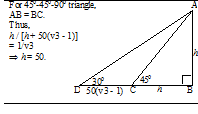| Month | Salary | Expenses | Saving |
| January | 7200 | 6000+ 5% of 6000 = 6300 | 7200-6300-900 |
| February | 7200 | 6300+5% of 6300= 6615 | 7200-6615=585 |
| March | 7200 | 6615+5% of 6615= 6945.75 | 7200-6945.75=254.25 |
| April | 7200 | 6945.75+ 5% of 6945.75 = 7293.0375 | Expenses are more than salary |

